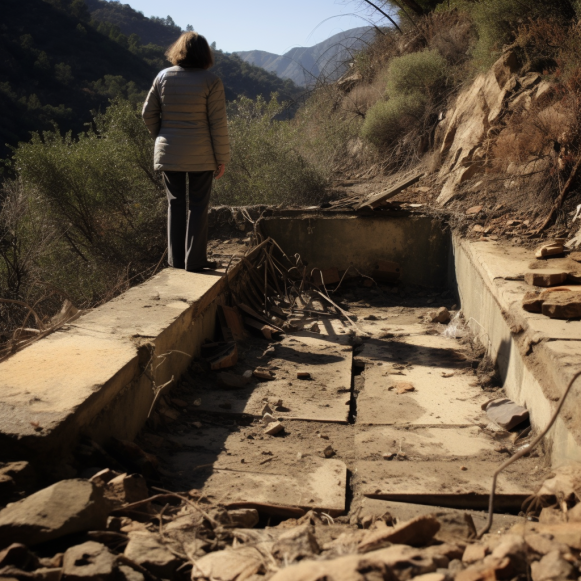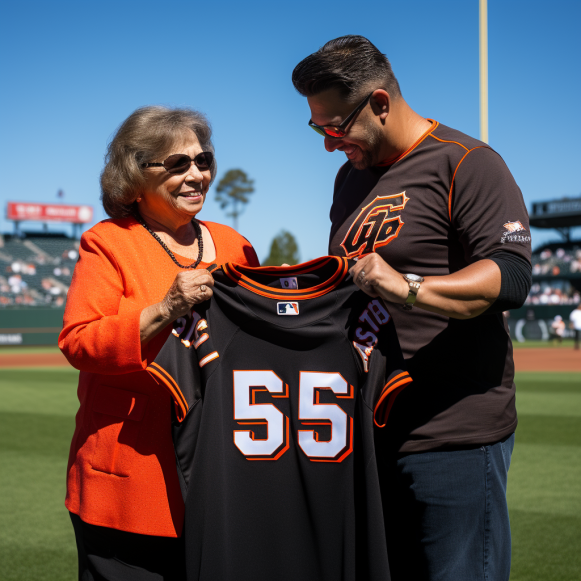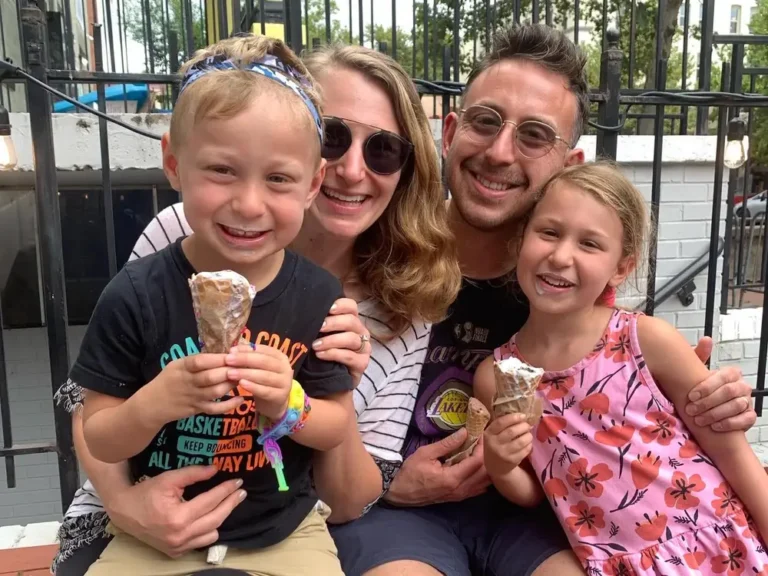The nearly 500 Californians killed in the 1928 St. Francis Dam disaster might finally get a memorial

It was Southern California’s largest civil engineering disaster.
In February 1928, Phillip Cesena was transferred to San Franciscquito Canyon to work as a ranch hand, mucking out stalls and exercising ranch animals.
The 15-year-old had recently lost his father, Leonardo, and wanted to help support his mother, Erolinda, and his 12 siblings by learning how to break horses and perform trick riding for Hollywood westerns.
Cesena’s fate was sealed a month later.
The St. Francis Dam burst, unleashing a torrent of 12.6 billion gallons of water 15 stories high through Santa Clarita, Saugus, Saticoy, Piru, Fillmore, and Santa Paula.
The water destroyed villages and killed approximately 450 people before reaching the ocean 54 miles away in Oxnard.
Cesena is buried next to his mother in an unmarked grave near the dam site.
The story of the boy — whose surviving photo shows him standing on a mule practicing a trick he learned from the Navajos — is buried under concrete ruins and decades of indifference from a ruling class that cared more about water rights, real estate, and power than honor, like so many others who died when the dam collapsed on March 12, 1928.
Now, a community organizer is spearheading a campaign to erect a memorial to Cesena and all those who died in what some call the worst civil engineering disaster in the country’s history.
Dams, water, and death
Dianne Erskine-Hellrigel, a Newhall resident and executive director of the Community Hiking Club of Santa Clarita, is haunted by the tension between a rush to grow Los Angeles and a poorly built dam that took lives and psychologically harmed others.
Such anonymity in death, especially when it is part of the second-largest disaster in California history, she says, is both tragic and worthy of public hearing.
“They are forgotten, and this should not be the case.” They should not be forgotten. They were all good people. “They didn’t stand a chance,” she said.
The community organizer has lectured, lobbied, and tracked down survivors’ relatives in order to recreate their harrowing stories in order for their names to be etched in marble and their stories retold in a new museum — part of a national memorial at the site of the St. Francis Dam, located some 47 miles northeast of Los Angeles in the Angeles National Forest but now surrounded by Santa Clarita tract homes.
The St. Francis Dam Disaster National Memorial Act, introduced by Rep. Steve Knight, R-Santa Clarita, and Sen. Kamala Harris, D-Calif., would honor the dead and tell the stories of those who survived.S.B.1926 has passed the House and is now awaiting approval from the Department of Agriculture and the United States Senate.
The memorial would be the country’s 37th, following the Washington Memorial and the 9-11 Memorial. It would be the first in forest land managed by the United States Forest Service.
Activists have met with USFS officials and potential donors such as Southern California Edison, which lost 86 men in the disaster, the Los Angeles Department of Water and Power, which officially supports the bill, and corporations in the hopes of raising $2 million in seed money if the designation is granted.
“This is going to be the crown jewel of the United States Forest Service,” Erskine-Hellrigel predicted.
Two tales
Erskine-Hellrigel has two stories he wants to tell.
The first is of William Mulholland, who, along with Fred Eaton, designed and built a 233-mile aqueduct that funnels water from the Owens Valley into Los Angeles homes, faucets, and bathtubs.
Mulholland rose through the ranks of the new Los Angeles Bureau of Water Works and Supply, a precursor to today’s Los Angeles Department of Water and Power, from water-pipe ditch digger to first manager and chief engineer.
He then constructed five local dams to hold aqueduct water. He was well aware that droughts interrupted and restarted flows from the Owens Valley, and he correctly predicted that reservoirs were required in Los Angeles.
In 1925, he began construction on St. Francis, which would eventually become the largest gravity arch dam in the United States. The dam, wedged between two canyon walls, was constructed of concrete and stood 208 feet tall, spanning 1,300 feet.
On March 12, 1928, two minutes before midnight, it was filled to about three inches from the top with a year’s worth of water for the growing city.
Dam keeper Tony Harnischfeger had noticed muddy discharge spurting from the dam earlier that day. Dams would frequently leak, but when the water turned brown, he immediately thought of an eroding base.
He dialed Mulholland’s number. They determined with the help of a lieutenant that the dirt from a nearby road had turned the water brown.
Mulholland concluded that nothing was eroding and ate a late lunch in downtown Los Angeles.
“That was a decision he would regret for the rest of his life,” said Dr. Alan Pollack of the Santa Clarita Valley Historical Society. “Had Mulholland known there was a problem, he would have evacuated the area.”
“He was their celebrity plus — their superhero.” Then this happens, leaving a huge black mark on the city as well as a black mark on their hero.”
Pollack elaborated on the event’s aftermath during a recent walk through the ruins of the dam, which are still visible in the canyon off San Francisquito Canyon Road.
“They wanted to get this out of public memory as soon as possible,” he explained. “So they settled lawsuits with the victims and decided to blow up (the center portion that remained standing, morbidly nicknamed The Tombstone) in 1929.”
In memory of the victims and survivors
The second story Erskine-Hellrigel wishes to tell is about the people who have died. She’s gone to great lengths to record their transactions.
Tony Harnischfeger, the dam keeper, was never found. The body of his girlfriend, Leona Johnson, was discovered first.
She did not perish. Her body was crushed by a rock at the base of the massive dam.
“Rumors persist that he told his honey, ‘I’ll be right back,’ but then took off for Mexico,” Erskine-Hellrigel said, “and he spent the rest of his life down there sipping margaritas and having a good time.”
Ann Stansell, a researcher at Cal State Northridge, has compiled a list of victims, some of whom are marked as “missing.” The majority of the victims have Latino surnames — ranchers, farmhands, and farm workers.
Ray Rising, who worked at Powerhouse #2, which used water from the Owens Valley Aqueduct to generate electricity, miraculously survived and went back to work for what is now LADWP.
Carol Rising Longo, Erskine-Hellrigel’s daughter from his second marriage, was found on Facebook only a few years ago. She was open to discussing what her father had told her. Longo had not heard the incredible story of her father’s escape.
Rising would enjoy swimming in the reservoir after work. When the flood hit that terrible night, his skills came in handy.
Julia, his wife at the time, drowned. According to the coroner’s report, his 7-year-old daughter Delores drowned, possibly in her mother’s arms.
Their two other children, Adaline, 1, and Glenn, 5, were killed by debris that “crushed and mangled” their bodies, according to the coroner.
Ray Rising swam and swam but got caught in power lines. As he struggled to break free, he grabbed a passing house and dragged himself up to the roof, where he rode the current. He later jumped off the cliff to safety.
“The water had ripped his clothes off,” said Erskine-Hellrigel.
Lillian Curtis returned to the Powerhouse #2 village and climbed to the top of a hill to escape the rising waters. She clung to her 2-year-old son, Danny, and charged up a steep hill. There, she dug a hole for her son and placed the dog on top to keep him warm.
‘”Mommy, please don’t let the water take us,'” Danny said, according to the account.
Rising later joined them there to await assistance.
Looking up at that hill on a recent sunny day, Erskine-Hellrigel said, “I can still see that hole she put her son in, even though it has been 90 years.”
They were the only survivors from that village.
When asked what she said to rescuers in a 1978 newspaper report, Curtis replied, “All I could do was scream, scream, scream.”
When Erskine-Hellrigel places a tombstone at Cesena’s grave next month — raising funds for the effort through her 501C3, St. Francis Dam National Memorial Foundation — she’ll do the same for Johnny and Emma Traxler, who are buried in a Chatsworth cemetery with no markings.
Little Johnny, 3, and his mother were on their way from Modesto, most likely to avoid Traxler’s husband.
“Oh yeah, I’m sure she was leaving him,” Erskine-Hellrigel said, adding that the husband received the death benefit but refused to provide a funeral or a gravestone for his wife or toddler.
Traxler and her son spent the night at Castaic Junction, but their cabin was washed away by the Santa Clara River.
Johnny’s body was discovered alone in the cabin. It took months for authorities to figure out he belonged to Traxler, whose body was discovered miles away.
According to her, the sheriff of Newhall paid for the caskets. The cemetery’s owner gave up his family plot.
“The silent film actor William S. Hart took a liking to the little boy and dubbed him ‘Our Little Soldier,'” Erskine-Hellrigel explained, adding firmly:
“If it’s the last thing I do, they’ll get a headstone.”
Conservation of ruins, fish, and frogs
On Monday, August 27, Erskine-Hellrigel and Pollack take a slow, eerie walk through the dusty paths of the former reservoir.
They point out rocks that are actually dam pieces. One large section, weighing about 20 tons, sits miles from the dam site, looking like an alien spaceship.
One side of the proposed visitors center, according to Erskine-Hellrigel, will tell the story of water in Los Angeles. The other side will recount the dam’s collapse and the people who died — and survived.
The view from the top of the dam’s westernmost section is of willows and other green trees swaying in the hot breeze. The riparian area, which she refers to as a bog, remains wet all year, which is unusual for arid Southern California.
More than 400 acres will be preserved as part of the memorial, including San Francisquito Creek, which is home to the endangered unarmored threespine stickleback fish.Erskine-Hellrigel wants to remove the old road to open up more habitat for the fish.
The California red-legged frog, the state amphibian and a threatened species, can be found in small numbers in the nearby creek.
“We intend to construct a raised boardwalk to protect the area.” Think about it: we have a bog in Southern California!” According to Erskine-Hellrigel.
She stated that the memorial will not be used to point fingers.
“Most of the survivors’ relatives said they have no ill will toward Mulholland.” “All they say is that it happened,” she explained.
“We are not assigning blame. We’re carrying all of history forward.”





